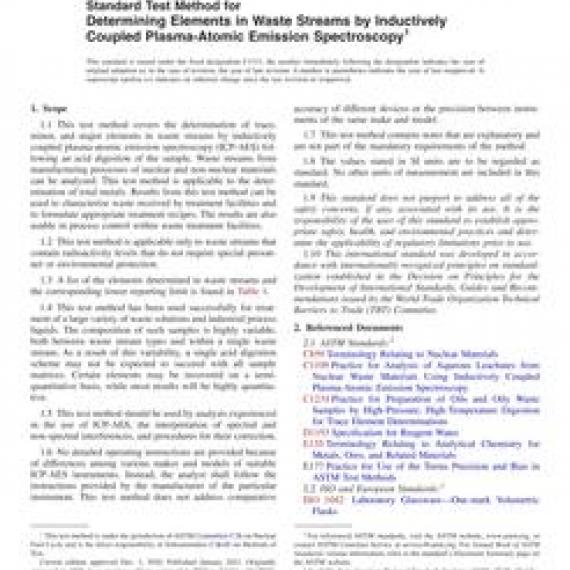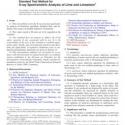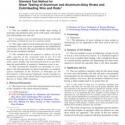ASTM C1111-10(2020)
ASTM C1111-10(2020) Standard Test Method for Determining Elements in Waste Streams by Inductively Coupled Plasma-Atomic Emission Spectroscopy
standard by ASTM International, 12/01/2020
Full Description
1.1''This test method covers the determination of trace, minor, and major elements in waste streams by inductively coupled plasma-atomic emission spectroscopy (ICP-AES) following an acid digestion of the sample. Waste streams from manufacturing processes of nuclear and non-nuclear materials can be analyzed. This test method is applicable to the determination of total metals. Results from this test method can be used to characterize waste received by treatment facilities and to formulate appropriate treatment recipes. The results are also usable in process control within waste treatment facilities.
1.2''This test method is applicable only to waste streams that contain radioactivity levels that do not require special personnel or environmental protection.
1.3''A list of the elements determined in waste streams and the corresponding lower reporting limit is found in Table 1.
1.4''This test method has been used successfully for treatment of a large variety of waste solutions and industrial process liquids. The composition of such samples is highly variable, both between waste stream types and within a single waste stream. As a result of this variability, a single acid digestion scheme may not be expected to succeed with all sample matrices. Certain elements may be recovered on a semi-quantitative basis, while most results will be highly quantitative.
1.5''This test method should be used by analysts experienced in the use of ICP-AES, the interpretation of spectral and non-spectral interferences, and procedures for their correction.
1.6''No detailed operating instructions are provided because of differences among various makes and models of suitable ICP-AES instruments. Instead, the analyst shall follow the instructions provided by the manufacturer of the particular instrument. This test method does not address comparative accuracy of different devices or the precision between instruments of the same make and model.
1.7''This test method contains notes that are explanatory and are not part of the mandatory requirements of the method.
1.8''The values stated in SI units are to be regarded as standard. No other units of measurement are included in this standard.
1.9''This standard does not purport to address all of the safety concerns, if any, associated with its use. It is the responsibility of the user of this standard to establish appropriate safety, health, and environmental practices and determine the applicability of regulatory limitations prior to use.
1.10''This international standard was developed in accordance with internationally recognized principles on standardization established in the Decision on Principles for the Development of International Standards, Guides and Recommendations issued by the World Trade Organization Technical Barriers to Trade (TBT) Committee.


































